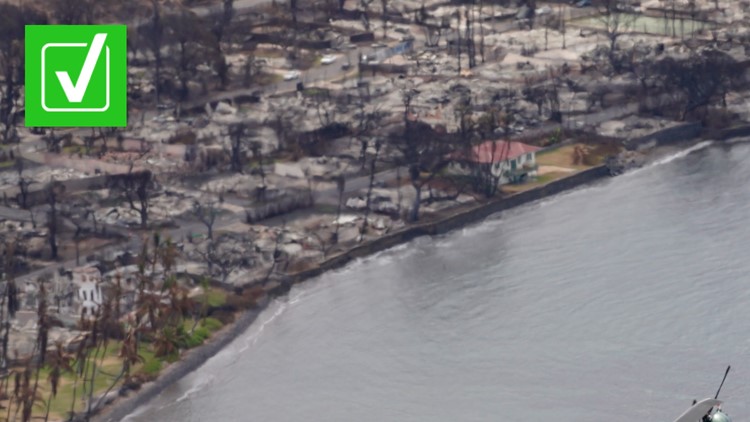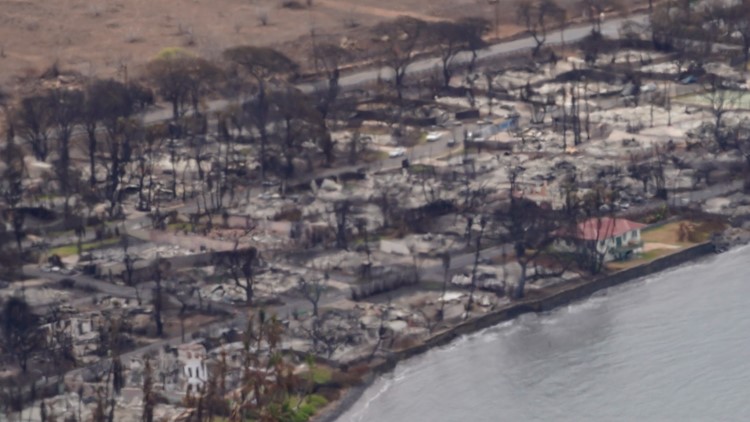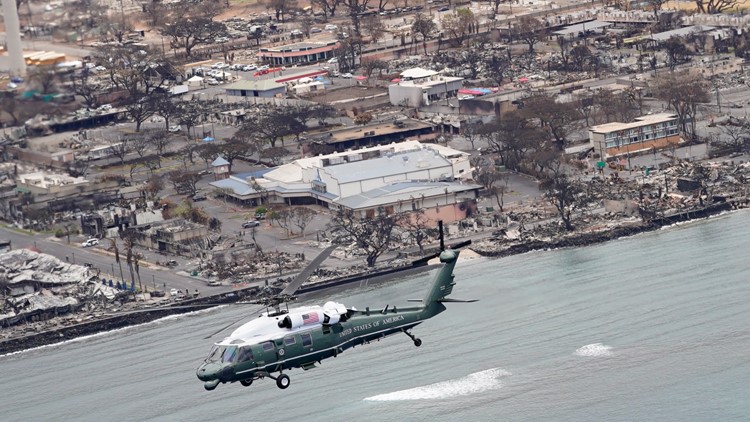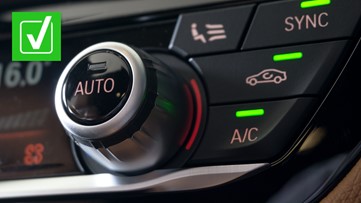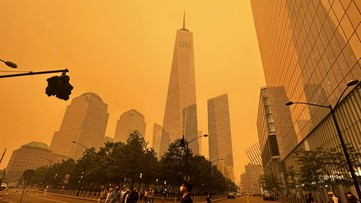Photos of the Aug. 8 and 9 wildfire that consumed Lahaina on Maui show a devastated town that looks almost entirely destroyed. Building after building is reduced to nothing more than rubble, cars are entirely burned out and trees are charred black and leafless.
That has made photos of a house dubbed the “miracle house” all the more unbelievable. People on social media have questioned the authenticity of the photos and wondered why this house in particular would survive when all of its neighbors did not. Multiple VERIFY readers have asked us the same questions.
THE QUESTION
Are photos of Lahaina’s “miracle house” real?
THE SOURCES
THE ANSWER
Yes, photos of Lahaina’s “miracle house” are real. The building's survival likely depended on a few key factors, including its roof, landscaping and location.
WHAT WE FOUND
The “miracle house” appears in photos by Getty Images and can also be seen in the background of this Associated Press photo of President Joe Biden’s helicopter approaching Lahaina. Both the Getty and the AP images show the house stands seemingly undamaged while all of the surrounding buildings are rubble.
Other photos from Getty and the AP reveal other structures that also survived the fires. Getty and the AP both photographed the Lahaina Shores Beach Resort standing alone in a neighborhood of rubble and ash. A few other aerial photos from Getty and the AP show sparse buildings that withstood the fires spread throughout the town.
Buildings still standing in Lahaina
So how did the miracle house and the few other surviving buildings withstand flames that destroyed most of the other structures in Lahaina? Simply put, some buildings are just more fire resistant than others.
In the case of the miracle house, recent renovations made by the home’s owners likely played a role, according to reporting from Honolulu Civil Beat, a local nonprofit news organization. The homeowners purchased the house, which is believed to be nearly 100 years old, in 2021, and began a two-year renovation project in line with a historic preservation plan.
As part of these renovations, the homeowners installed a commercial-grade steel roof and replaced the landscaping about a meter around the house with river stones, Honolulu Civil Beat reported.
According to the National Fire Protection Association (NFPA), the main way wildfires ignite homes is with small fires and embers, which are tiny pieces of burning wood or vegetation that float with the wind. And these small fires and embers don’t have to come from the main fire itself. For example, an analysis of a California wildfire found that 193 of the 199 residential homes burned in the fire were ignited by the flames of other nearby homes — not the wildfire itself.
Aerial photos of the miracle house show it had more space between it and other houses than there was between most of the other nearby structures, so it would have been less likely to catch fire from the flames of nearby houses. In fact, the other structures seen standing in Getty’s and the AP’s photographs also have more space between them and other structures as compared to most of the surrounding community.
The NFPA says the most important areas to fireproof to protect your home are the home itself and the immediate five feet around it. You should keep the immediate five feet around your home a “non-combustible zone” by removing any flammable materials from it. River stones, like those used around the Lahaina miracle house, would accomplish that.
The California Department of Forestry and Fire Protection, CalFire for short, says the roof is the most vulnerable part of your home. While homes with shingle or wood roofs are more likely to be destroyed in a fire, homes with metal, clay or tile roofs are more fire resistant.
Some people have also been confused by trees seen standing in Lahaina after the fire. Satellite imagery shows that while a few trees in the town remain standing, most have been burned. Fire resistance varies between trees, just like it does between houses.
For example, post-fire photos of the famed banyan tree in the middle of Lahaina show the tree is charred, but still standing. CABI, a nonprofit science information organization, says that while the banyan tree is susceptible to fire, “seldom are its many stems all killed by fire.” During President Biden's tour of the damage in Maui on Monday, he called the banyan tree a "diamond in the rough of hope."
In places where wildfires are historically frequent, many trees have adapted to resist or even rely on wildfires. Regular large wildfires weren’t common in the Hawaiian islands until recently, and so in general the islands’ native plants aren’t equipped to deal with regular fires, the Hawaii Division of Forestry and Wildlife says. There are still some fire resistant trees, however, like the māmane.

